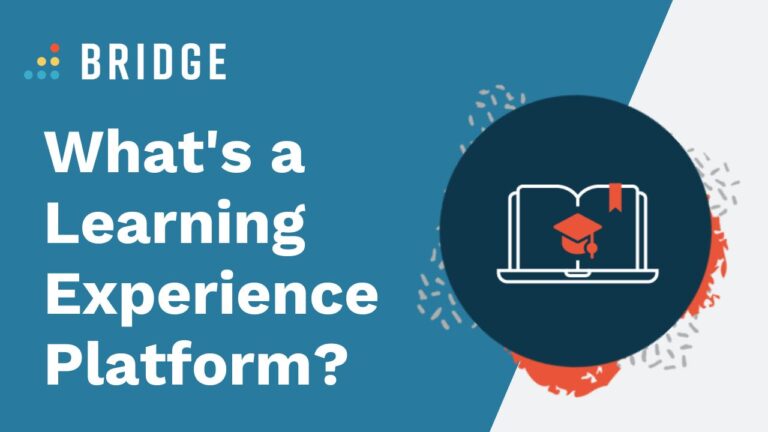Learning experience platforms (LXPs) have become a popular new learning technology within the L&D industry. But what exactly is a learning experience platform? Let’s cover the basics—including how an LXP differs from a learning management system (LMS).
For years, the L&D industry has considered learning management systems (LMSs) to be the foundation of the learning ecosystem. However, learning happens everywhere—not just in the LMS and other formal settings.
While the LMS continues to play an important role in corporate training, as new tools and technologies emerge, it’s no longer always considered to be the center of the modern learning ecosystem.
In particular, learning experience platforms are quickly gaining traction in the L&D space. So what is an LXP and why should you consider using one?
At its core, an LXP (sometimes called an LEP or LEXP) creates personalized learning experiences by integrating and consolidating formal and informal learning initiatives—including LMS training programs—from across the organization.
As a result, many LXPs offer both learners and stakeholders a single point of access to
- Discover, gain, and share knowledge
- Create, curate, and aggregate content
- Engage and collaborate with one another
- Track learning programs, and more.
YOU MIGHT ALSO LIKE | ‘4 Ways to Personalize the Learning Journey’
What’s the Difference between an LXP and LMS?
Historically, an LMS is a closed system that organizes and delivers formal learning content that’s been created by the L&D team using a content management system or authoring tool. That means learners and other non-admin users are confined to the content in the LMS, increasing the chances that these users will seek other sources when their assigned training doesn’t answer or address their questions.
Many LMSs also allow organizations to track and evaluate learners’ activity and progress, but their closed systems prevent them from being able to deliver and track informal learning. This limited view means you’re not getting the full picture of all the learning that’s actually happening in your organization.
In contrast, a learning experience platform (LXP) is an open system that pulls learning from a wide array of sources into one central location. This allows you to deliver mandatory training—such as compliance or onboarding courses—you’d typically provide via an LMS, as well as educational content and resources from other tools and third-party providers across multiple channels.
LXPs help users customize their learning paths while allowing them to share and recommend relevant content to fellow users. So when learners find a helpful resource that answers a commonly asked question, they can submit that resource so it’s easily accessible to peers. And when learners feel like they’re involved in the process, they’re more likely to engage with and explore learning opportunities.
Furthermore, the flexibility of an open system allows L&D teams to grow and diversify their content library exponentially faster than if they had to create and curate content on their own.
Like most LMSs, most LXPs also offer basic reporting and analytics—such as learner usage, activity, and performance. Unlike an LMS, though, LXP reporting includes information from multiple data sources, giving you a more well-rounded understanding of your learners, their progress, and how they’re interacting with content.
HANDPICKED FOR YOU | ‘5 Great Ways to Encourage Social Learning In the Workplace‘
Who Needs a Learning Experience Platform?
Generally speaking, LXPs are intended primarily for organizational learning and development—as they’re designed to aggregate, house, and deliver a vast assortment of training spanning teams, departments, and businesses.
What Types of Learning Can a Learning Experience Platform Deliver?
LXPs can host multiple content types, ranging from custom interactive courses and video presentations to curated podcasts and articles. Common, but not standard features, may include
- Built-in authoring and content management tools
- The ability to create user profiles and join communities to discuss and share content
- Mobile-friendly options for on-the-go learning
- Auto-generated recommendations based on job roles or past learning experiences
- Self-publishing options depending on user permissions
- Automated workflows as learners progress through courses
- Integrations with other learning tools and platforms.
Do I Need an LXP, LMS, or Both?
Not sure if you need a learning experience platform, learning management system, or both? Use the handy guide below to fit the right fit.
Use an LMS to:
- Deliver live, in-person training
- Provide instructor-led training
- Schedule required training, rooms, and/or resources (e.g. manage waitlists and room occupancy)
Use an LXP to:
- Deliver just-in-time training
- Offer performance support
- Provide coaching or role-play simulations
Integrate an LXP and LMS to:
- Launch and track LXP-created content in your LMS
- Link to or embed the LXP as the content library within your LMS
- Connect all your L&D program data through a learning record store (LRS) and/or learning analytics platform (LAP) for robust reporting and analytics
RELATED READING | ‘Delivering Results: The Importance of Tracking Employee Learning’
Creating a Culture of Continuous, Scalable Learning
As the LXP market continues to evolve, you can expect to see new features and capabilities that further enhance organizational learning efforts and the user experience. For organizations looking to create a dynamic, continuous learning culture, having the right training platform is key to creating and delivering L&D programs that are engaging, scalable, and—most important—that meet the needs of both your organization and learners.




